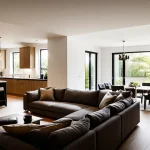The Link Between Home Design Choices and Personal Well-being
The connection between home design and well-being is profound, directly influencing both mental and physical health. Studies consistently show that the psychological effects of a thoughtfully designed home environment extend beyond aesthetics, impacting mood and overall emotional balance. When design choices align with comfort and functionality, they foster a positive atmosphere that encourages relaxation and reduces stress.
Research reveals key elements that shape this impact. Natural materials, soothing color palettes, and organized spaces can promote tranquility, while chaotic layouts or harsh designs tend to elevate anxiety. The presence of light, air flow, and personal space are crucial components, affecting how residents feel day-to-day.
This might interest you : What Are the Top Mistakes to Avoid When Designing a Cozy Home Environment?
Understanding the impact on mood means recognizing that a home’s structure and contents can serve as either a refuge or a source of tension. Spaces designed for comfort, with attention to sensory stimuli such as lighting and texture, support emotional resilience. This makes careful planning of home environments essential, offering tangible benefits to well-being that extend into daily life.
The Role of Lighting in Mood and Productivity
Lighting plays a critical role in shaping psychological effects of home environment, directly influencing both mood and productivity. Natural light offers numerous benefits, including the regulation of the circadian rhythm, which governs sleep-wake cycles and overall alertness. Exposure to sufficient daylight helps maintain a healthy internal clock, reducing risks of sleep disorders and supporting emotional balance.
In the same genre : What are the essential elements of a traditional UK home?
Conversely, artificial lighting, if poorly designed, can disrupt these natural rhythms, contributing to fatigue and decreased mental clarity. The impact on mood varies with light intensity and color temperature; warmer tones tend to relax occupants, while cooler, brighter lights can enhance focus and energy.
Practical lighting strategies involve maximizing daylight through windows and skylights, complemented by layered artificial lighting to suit different activities. For example, task lighting in work areas boosts productivity, while softer ambient lighting in living spaces fosters calmness. Thoughtful lighting design enhances home design and well-being by harmonizing the environment with human biological needs, supporting both mental health and daily function.
The Psychological Power of Color Schemes
Color psychology deeply influences psychological effects of home environment by affecting emotions and behaviour. Research shows that different hues can evoke distinct responses; for example, blues and greens tend to calm the mind, reducing stress and anxiety, while reds and oranges often energize and stimulate activity. This direct impact on mood makes thoughtful color selection vital in home design and well-being.
Scientific studies in color psychology reveal that cool colors promote relaxation, making them ideal for bedrooms or meditation areas, whereas warm colors can boost alertness and conversation, perfect for kitchens or social spaces. Moreover, neutral tones provide balance, creating spaces that feel stable and soothing.
When applying color schemes, consider the room’s purpose and natural lighting. A well-chosen palette enhances not only aesthetics but also occupants’ mental health. Blending calming colors in resting areas with vibrant ones in active zones supports emotional balance and functionality. Using color strategically allows homeowners to harness the home design and well-being connection, creating environments that nurture both spirit and mind.
Importance of Layout and Space Organisation
Thoughtful home layout directly influences mental health by shaping how comfortable and calm residents feel. Open layouts encourage airflow and natural movement, reducing feelings of confinement and stress. Conversely, cramped or cluttered spaces increase anxiety, hamper focus, and contribute to sensory overload.
The psychological effects of home environment are strongly affected by clutter, which studies link to heightened cortisol levels and decreased cognitive function. How spaces are organised matters just as much as size. Efficient space planning creates zones for different activities, helping residents mentally switch between work, leisure, and rest.
For small or busy homes, practical steps include:
- Minimising unnecessary items through regular decluttering
- Using multifunctional furniture to maximise usable space
- Incorporating storage solutions that keep belongings orderly yet accessible
Such strategies support a harmonious environment, enhancing the impact on mood by fostering order and ease. This alignment between layout and mental well-being demonstrates why prioritising thoughtful organisation is essential in home design and well-being efforts.
Choosing Furniture and Materials for Comfort and Health
Selecting the right furniture and materials plays a pivotal role in home design and well-being, directly influencing comfort and physical health. Ergonomic furniture supports posture and reduces strain, which in turn lowers stress levels and promotes positive psychological effects of the home environment. For example, an adjustable chair tailored to one’s body can prevent back pain and improve focus, enhancing overall impact on mood.
In addition to ergonomics, choosing healthy materials is essential. Hypoallergenic fabrics and non-toxic finishes help minimize allergens and chemical exposure, fostering cleaner air quality and better respiratory health. Natural materials like wood and organic textiles not only support environmental sustainability but also contribute to a soothing atmosphere.
Sustainable interiors combine health benefits with ecological responsibility, encouraging mindful consumption. Incorporating furniture made from renewable resources reduces environmental toxins in the home, reinforcing a healthier living space.
By prioritizing ergonomic, hypoallergenic, and sustainable choices, homeowners can create environments that nurture physical wellbeing and emotional balance, reinforcing the profound link between home design and well-being.






